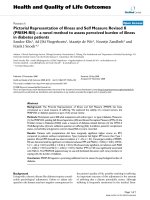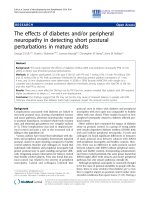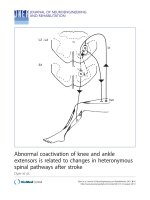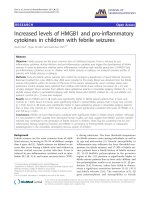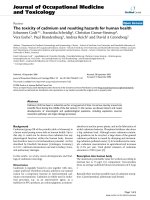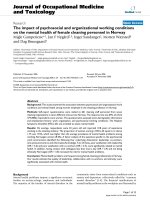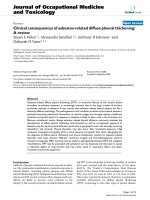báo cáo hóa học:" Exposure rate of needlestick and sharps injuries among Australian veterinarians" ppt
Bạn đang xem bản rút gọn của tài liệu. Xem và tải ngay bản đầy đủ của tài liệu tại đây (199.77 KB, 6 trang )
BioMed Central
Page 1 of 6
(page number not for citation purposes)
Journal of Occupational Medicine
and Toxicology
Open Access
Research
Exposure rate of needlestick and sharps injuries among Australian
veterinarians
Peter A Leggat*
1,2
, Derek R Smith
2,1
and Richard Speare
1
Address:
1
Anton Breinl Centre for Public Health and Tropical Medicine, James Cook University, Townsville, Queensland, 4811, Australia and
2
WorkCover New South Wales Research Centre of Excellence, Faculty of Health, University of Newcastle, Ourimbah, New South Wales, 2258,
Australia
Email: Peter A Leggat* - ; Derek R Smith - ; Richard Speare -
* Corresponding author
Abstract
Background: Needlestick and sharps injuries (NSI) represent an important occupational health
issue in veterinary practice. Little is known about the distribution and correlates of NSI among
Australian veterinarians.
Methods: A questionnaire-based NSI survey was mailed to 1094 veterinarians registered with the
Veterinary Surgeons Board of Queensland during 2006.
Results: A total of 664 surveys were returned from 1038 eligible participants (response rate
64.0%) with 56.8% being male, around one-third in the >50 years age group and about half aged
3150 years. Just over two-fifths were working in small animal practice only. Around three quarters
(75.3%) reported suffering at least one NSI in the previous 12 months, while 58.9% reported
suffering from at least one contaminated NSI during the previous 12 months, which crudely
extrapolates to an exposure rate of 75.3 and 58.9 NSI per 100 person-years respectively. Risk
factors for contaminated NSI were female gender, working in small or mixed animal practice, being
less experienced, seeing more patients per week and working longer hours per week. The most
common causative devices were syringes (63.7%), suture needles (50.6%) and scalpel blades
(34.8%).
Conclusion: The exposure rate of NSI is high for Queensland veterinarians and clearly remains a
major occupational health problem. Current guidelines and strategies to reduce NSI in veterinary
practice should be promoted, but appear to be adapted from human health care. Studies to
understand why veterinarians have such high NSI rates are required to not only identify risk factors
for NSI, but also to determine attitudes and beliefs about NSI. From these studies specific strategies
for veterinarians can be designed and trialed to develop evidence-based guidelines and policies that
are effective in decreasing the exposure rate of NSI in veterinary practice.
Introduction
Needlestick and sharps injuries (NSI) represent an impor-
tant occupational health and safety issue in contemporary
health care practice. Communicable diseases transmitted
by NSI that commonly trouble health care workers
(HCW), such as viral hepatitis and Human Immunodefi-
ciency Virus, are of little concern for veterinarians, except
those dealing with non-human primates [1]. Although
Published: 28 August 2009
Journal of Occupational Medicine and Toxicology 2009, 4:25 doi:10.1186/1745-6673-4-25
Received: 24 July 2009
Accepted: 28 August 2009
This article is available from: />© 2009 Leggat et al; licensee BioMed Central Ltd.
This is an Open Access article distributed under the terms of the Creative Commons Attribution License ( />),
which permits unrestricted use, distribution, and reproduction in any medium, provided the original work is properly cited.
Journal of Occupational Medicine and Toxicology 2009, 4:25 />Page 2 of 6
(page number not for citation purposes)
zoonotic diseases are common, there are few pathogens of
domestic animals that are transmitted to humans by the
blood borne route. Bartonella spp. in cats appears to be the
only zoonotic pathogen that causes chronic and recurrent
bacteraemias in animals [2]. Transmission of B. henselae
to a human via the bite of an infected cat flea highlighted
that transmission by NSI could occur in theory [3], but no
cases have been reported after NSI in small animal prac-
tice. Reports of communicable diseases acquired by NSI in
veterinarians or animal attendants are rare. NSI was not a
risk factor for seropositivity for leptospirosis in veterinari-
ans in USA [4]. We could locate only two reports in veter-
inary practice where a NSI resulted in a zoonotic disease:
Herpesvirus simiae from a Rhesus monkey that infected
an animal attendant after a NSI [5] and blastomycosis that
developed in a veterinarian after a NSI associated with a
fine needle aspiration [6]. Although the recent NSI of a
veterinarian while euthanizing a horse positive for Hen-
dra virus, a PC4 emerging infectious disease agent with a
high case fatality rate, highlighted the potential zoonotic
risks that veterinarians now face [7], blood borne trans-
mission of zoonotic pathogens have been considered a
minor hazard for veterinarians.
Hence, in veterinary practice the emphasis on hazard from
NSI has been on accidental injection of manufactured
biologicals and parenteral drugs (including antibiotics,
chemotherapeutics, euthanasia solutions, tranquilisers,
and anaesthetic agents) rather than infectious agents from
animals [1]. The major reason for this is that veterinary
patients are far less compliant than human patients and
movement of the animal at the time of needle puncture is
common. This increases the risk of NSI for the veterinar-
ian and the chances that syringes will contain therapeutic
substances. In a survey of Wisconsin veterinarians inject-
ing cattle, 63% of NSI occurred during injection [8], while
a study on HCW found only 39% of NSI occurred during
the procedure [9]. Examples of biologicals that veterinari-
ans are particularly concerned about include Strain 19 and
RB51 vaccines (live attenuated Brucella abortus for the con-
trol of bovine brucellosis) and Johne's vaccine (killed
Mycobacterium paratuberculosis) for the control of Johne's
disease in cattle and sheep as well as other vaccines with a
similar oily adjuvant. A Canadian survey of veterinarians
who vaccinated calves with Strain 19 found 46% had
injected themselves at least once and of these at least 45%
developed moderate to severe reactions [10]. There is one
report of a veterinarian who apparently died after a NSI
with Strain 19 [11]. For RB51, accidental inoculations
have been reported with local or systemic reactions
[12,13]. For Johne's disease vaccine 9.5% of Wisconsin
veterinarians using the vaccine had accidentally inocu-
lated themselves and 26% of NSI caused reactions [8].
Surgical debridement to remove the oily adjuvant is now
recommended after injection of Johne's disease vaccine
and other vaccines with a similar adjuvant [14]. Vaccines
were involved in 40% of NSI in zoo veterinarians in the
USA [15].
The other major concern veterinarians have about NSI is
accidental injection of pharmaceutical compounds, in
particular, drugs used to immobilise large animals [16].
Etorphine™, a very potent injectable synthetic narcotic
used in large animals as Immobilon™, was so potent that
even accidental application to skin was potentially fatal
[17]. Immobilon™ was perceived as such a risk that after
several death and near-death episodes involving veterinar-
ians, its use was severely restricted by legislation [18].
Hormones from NSI can also be a hazard; a female veter-
inarian spontaneously aborted after a NSI with a prostag-
landin [19]. Other drugs have been involved in reactions
after NSI including fentanyl [16] and tilmicosin [20].
Within the veterinary profession since the emphasis has
been less on NSI per se, and more on the potential effects
of the syringe contents, the prevention of NSI was for
many years a much lower priority than in HCW.
NSI has not been widely investigated in the veterinary pro-
fession and only a few studies report incidence (NSI per
time per person) or exposure rate with most reporting life-
time prevalence. In one survey of female veterinarians in
USA, 64% reported one or more NSI during their careers,
with a reported incidence of 9.3 NSI per 100 person-years
[19]. Vaccines were associated with 50% of the incidents
in that study [19]. The incidence of NSI in the survey of
Wisconsin veterinarians vaccinating cattle with Johne's
disease vaccine was 5.5 NSI per 100 person-years [8]. A
survey of 735 veterinarians in USA found a much higher
rate of 0.45 NSI per respondent over three years, a rate of
15 NSI per 100 person-years [20]. Incidence of NSI in vet-
erinarians attending a national conference in USA was
74.2 per 100 person-years [4]. In another study examining
zoo veterinarians in the United States, 87% reported one
or more NSI with 6.5% requiring medical treatment [15].
In this study, more than half of respondents reported NSI
associated with animal blood, antimicrobials and vac-
cines [15]. In a Western Australian study of veterinary
practices, 71% of respondents had been injured over a 10
year period with the most common injuries being dog and
cat bites, cat scratches and NSI [21]. The study did not
specify the prevalence of NSI. In an Australian study of
veterinary nurses 71% reported NSI with about two-thirds
of these associated with injection of various substances,
including antibiotics (13%), euthanasia chemicals (11%),
sedatives (9%), vaccines (8%) and anaesthetics (8%) [22].
Although there is now a greater emphasis in veterinary
practice in Australia on prevention of NSI, little is known
about the current exposure rate of NSI among Australian
veterinarians [1]. Therefore, the current study was under-
Journal of Occupational Medicine and Toxicology 2009, 4:25 />Page 3 of 6
(page number not for citation purposes)
taken to investigate NSI among veterinarians registered in
Queensland, Australia.
Methods
This study involved a cross-sectional epidemiological
analysis of NSI among all veterinarians who were regis-
tered with the Veterinary Surgeons Board of Queensland
during 2006. Data was obtained by means of a mailed
self-reporting questionnaire. A three-page, A4-sized, self-
reporting questionnaire was subsequently mailed to each
veterinarian, including an information sheet and a reply
paid envelope. Two reminders were sent. All information
was collected anonymously, and informed consent was
implied when veterinarians completed and returned their
questionnaires. Our three-page survey included questions
such as age, sex, years in practice, type of practice, number
of patients seen per day, occurrence of NSI over the past
12 months, whether their injuries involved contaminated
devices (previously used on a patient), as well as the types
of devices causing the NSI. Data was analysed by statistical
software [23] to establish the exposure rate of NSI as well
as demographic correlates and possible risk factors. Differ-
ences in NSI exposure rates by sex and age (P for Trend)
were evaluated using the Chi-square test. P values below
0.05 were regarded as statistically significant throughout
all analyses. Ethical clearance for this study was obtained
from the James Cook University Human Research Ethics
Committee (No. H2465).
Results
Demographics
A total of 664 surveys were returned from 1038 eligible
veterinarians, giving a response rate of 64.0%. Demo-
graphic data is presented in Table 1.
Summary background data on age, number of years in
clinical practice, working hours per week, and number of
patients treated per day have been summarised by sex in
Table 2. Of the respondents 56.8% were male, about one-
third were >50 years and about half were aged 3150 years.
Just over two-fifths were working in small animal practice
only. Female veterinarians were significantly younger (p <
0.001) than their male counterparts.
NSI Prevalence
Around three-quarters (75.3 per cent) of veterinarians
reported at least one NSI in the previous 12-months and
58.9% reported at least one contaminated NSI during the
previous 12 months. Females were significantly more
likely to report having an NSI (82.6% verses 69.8%; p <
0.001) and a contaminated NSI (66.0% verses 53.7%; p <
0.01) in the previous 12 months. Table 2 indicates NSI
and contaminated NSI exposure rates by hours of work
per week, patients per week, years in practice and by type
of practice.
Causative Device
The prevalence of various devices causing NSI is stratified
by sex in Table 3. The most common causative devices
were syringes (63.7%), suture needles (50.6%) and scal-
pel blades (34.8%).
Discussion
This cross-sectional study examined the exposure rate and
other epidemiological characteristics of self-reported NSI.
The response rate for our study was relatively high (64%),
probably due to the interest in the topic, the short ques-
tionnaire itself and the follow-ups conducted. One of the
major limitations of this type of study is that what people
report may differ from their actual situation. Since we
selected all veterinarians registered in Queensland, our
final cohort of veterinarians is a reasonably comprehen-
sive sample for that state. We assume that since the veter-
inary profession in Australia is reasonably homogenous,
this survey will also reflect the situation in Australia as a
whole, but we have no evidence for this assumption.
The exposure rate of NSI reported by Queensland veteri-
narians is high, if we extrapolate the crude 12 month
exposure (75.3 per 100 person-years). However, it is sim-
ilar to the exposure rate of 74.2 NSI per 100 person-years
from a recent USA study [4]. These exposure rates are
higher than previous studies on veterinarians that ranged
between 5.515 NSI per 100 person-years [8,19,24]. The
exposure rate of NSI in Queensland veterinarians was,
however, much higher than that reported amongst den-
tists and nurses, using a similar methodology in the same
region, if we extrapolate the same crude 12 month expo-
sure (27.7 and 17.7 NSI per 100 person-years respectively)
[25,26]. It is also much higher than the prevalence rates
Table 1: Demographic Characteristics
Female Male Total
Demographics (%) (%) (%) P value
a
Age (years)
<30 (24.9) (6.1) (14.2)
3140 (36.7) (16.6) (25.7)
4150 (28.5) (23.4) (25.6) <0.001
>50 (10) (52.9) (34.6)
Type of Practice
b
Small animal (52.5) (36.6) (43.4) <0.001
Large animal (2.8) (10.6) (7.3) <0.001
Mixed animal (32.7) (30.8) (31.6) 0.324
Specialist (7.0) (8.2) (7.7) 0.341
Non-clinical (4.9) (7.7) (7.7) 0.013
University (6.3) (4.3) (5.2) 0.152
Other (1.4) (6.4) (4.2) <0.001
a
P for Trend evaluated using the chi square test by sex, except for
age;
b
Percentages for type of practice are percentages within sex.
Journal of Occupational Medicine and Toxicology 2009, 4:25 />Page 4 of 6
(page number not for citation purposes)
described for physicians in USA (423%) [27] and HCW in
UK (0.85 NSI per 100 person-years) [28]. Little has been
published concerning the risk factors for NSI in veterinar-
ians [1]. The findings that large animal practice was asso-
ciated with a significantly lower exposure rate of NSI and
that small animal and mixed practice was associated with
a significantly higher exposure rate of NSI are consistent
with that observed in a study of female veterinarians grad-
uated from US colleges [19]. The finding of a significant
trend towards a higher incidence of NSI amongst less
experienced veterinarians is consistent with that observed
in a study of personnel in two non-human primate labo-
ratories in the USA [29].
The high exposure rate of NSI revealed during this study
suggest that is very important that veterinarians observe
basic measures for reducing NSI, which are discussed else-
where [1], and examine the possibility of using safer
devices [1]. About two thirds of the "sharps" injuries were
contaminated "sharps" or NSI; however, one third were
non-contaminated. As such, it is important that veterinar-
ians remain vigilant for these types of exposures, so that
devices contaminated by the veterinarians themselves do
not subsequently create a downstream hazard for other
veterinary practice staff.
Our study showed that the most common "sharps" inju-
ries and contaminated "sharps" injuries among veterinar-
ians were from syringes, suture needles and scalpels,
which is consistent with previous studies from Western
Australia and other countries [15,19,21]. Of concern with
these NSI is the fact that they often occur while giving
injections or operating on the patient, when there is most
likely to be some residual pharmaceutical agent or bodily
fluid in the needle or on the instrument. It is important
that the Australian Veterinary Association's Code for
Infection Control [30] is adhered to in relation to prevent-
ing NSI and following any "sharps" injury during veteri-
nary practice [30]; however, the AVA Code lacks details.
Although prevention of NSI has been previously identi-
fied as an area needing more effective management
among veterinary personnel [1], it appears that current
guidelines to reduce NSI in veterinary practice are not
based on veterinary evidence, but are adapted from stud-
ies in human health care.
Table 2: Demographic and workplace items versus NSI exposure rate
Any NSI Contaminated NSI
Numbers (per 100 person-years) P value
a
Numbers (per 100 person-years) P value
a
Hours per week
<20 (55.6) P < 0.01 (44.4) P < 0.05
2030 (74.5) (50.9)
3150 (80.1) (62.2)
>50 (75.8) (61.6)
Patients per week
<20 (50.0) P < 0.001 (35.6) P < 0.001
2030 (82.0) (59.6)
3150 (83.2) (68.8)
>50 (86.6) (68.3)
Years as veterinarian
<5 (89.9) P < 0.001* (70.8) V
510 (80.2) (65.9)
1120 (79.9) (64.9)
>20 (66.9) (50.0)
Type of Practice
b
Small animal (83.6) P < 0.001 (63.4) P < 0.05
Large animal (58.3) P < 0.01* (37.5) P < 0.01*
Mixed animal (86.6) P < 0.001 (75.6) P < 0.001
Specialist (70.6) P = 0.420 (51.0) P = 0.233
Non-clinical (37.5) P < 0.001* (25.0) P < 0.001*
University (41.2) P < 0.001* (26.5) P < 0.001*
Other (31.0) P < 0.001* (17.2) P < 0.001*
a
Chi square for trend;
b
Percentages for type of practice are percentages of veterinarians reporting an NSI or contaminated NSI within these categories.
* Significantly lower reported prevalence of NSI or contaminated NSI during the previous 12 months
Journal of Occupational Medicine and Toxicology 2009, 4:25 />Page 5 of 6
(page number not for citation purposes)
Conclusion
The exposure rate of NSI is high for Queensland veterinar-
ians and clearly remains a major occupational health
problem. Current guidelines and strategies to reduce NSI
in veterinary practice should be promoted, but appear to
be adapted from human health care. Studies to under-
stand why veterinarians have such high NSI rates are
required to not only identify risk factors for NSI, but also
to determine attitudes and beliefs about NSI. From these
studies specific strategies for veterinarians can be designed
and trialed to develop evidence-based guidelines and pol-
icies that are effective in decreasing the exposure rate of
NSI in veterinary practice.
Competing interests
The authors declare that they have no competing interests.
Authors' contributions
PAL conceived of the study and gathered the data. PAL,
DRS and RS drafted the manuscript. PAL performed the
statistical analysis. All authors read and approved the
manuscript.
Acknowledgements
The authors are grateful to all veterinarians who completed our question-
naire. We would also like to acknowledge the assistance of Dr Frances W.
Leggat with data management.
References
1. Weese JS, Jack DC: Needlestick injuries in veterinary practice.
Can Vet J 2008, 49:780-784.
2. Chomel BB, Boulouis HJ, Maruyama S, Breitschwerdt EB: Bartonella
spp. in pets and effect on human health. Emerg Inf Dis 2006,
12:389-394.
3. Flexman JP, Lavis NJ, Kay ID, Watson M, Metcalf C, Pearman JW: Bar-
tonella henselae is a causative agent of cat scratch disease in
Australia. J Infect 1995, 31:241-245.
4. Spotts Whitney EA, Ailes E, Myers LM, Saliki JT, Berkelman RL: Prev-
alence of and risk factors for serum antibodies against Lept-
ospira serovars in US veterinarians. J Am Vet Med Assoc 2009,
234:938-944.
5. Artenstein AW, Hicks CB, Goodwin BS, Hilliard JK: Human infec-
tion with B virus following a needlestick injury. Reviews Inf Dis
1991, 13:288-291.
6. Ramsey D: Blastomycosis in a veterinarian. J Am Vet Med Assoc
1994, 205:968.
7. Perkins N: Independent review of Hendra virus cases at Red-
lands and Proserpine in July and August 2008. Toowoomba:
AusVet Animal Health Services; 2008.
8. Patterson CJ, LaVenture M, Hurley SS, Davis JP: Accidental self-
inoculation with Mycobacterium paratuberculosis bacterin
(Johne's bacterin) by veterinarians in Wisconsin. J Am Vet Med
Assoc 1988, 192:1197-1199.
9. Cullen BL, Genasi F, Symington I, Bagg J, McCreaddie M, Taylor A,
Henry M, Hutchinson SJ, Goldberg DJ: Potential for reported
needlestick injury prevention among healthcare workers
through safety device usage and improvement of guideline
adherence: expert panel assessment. J Hosp Infect 2006,
63:445-451.
10. Pivnick H, Worton H, Smith DLT, Barnum D: Infection of veteri-
narians in Ontario by Brucella abortus Strain 19. Canad J Public
Health 1966, 57:225-231.
11. Dalrymple-Champneys W: WHO mimeographed document.
WHO/BRUC/2004. 9 Feb 1960 1966.
12. Stauffer B, Reppert J, van Metre D, Fingland R, Kennedy G, Hansen G,
Pezzino G, Olsen S, Ewalt D: Human exposure to Brucella abor-
tus Strain RB51 Kansas, 1997. Morb Mort Weekly Rep 1998,
47:172-175.
13. Ashford DA, di Pietra J, Lingappa J, Woods C, Noll H, Neville B, Wey-
ant R, Bragg SL, Spiegel RA, Tappero J, Perkins BA: Adverse events
in humans associated with accidental exposure to the live-
stock brucellosis vaccine RB51. Vaccine 2004, 22:3435-3439.
14. Windsor PA, Bush R, Links I, Eppleston J: Injury caused by self-
inoculation with a vaccine of a Freund's complete adjuvant
nature (Gudair) used for control of ovine paratuberculosis.
Aust Vet J 2005, 83:216-220.
15. Hill DJ, Langley RL, Morrow WM: Occupational injuries and ill-
nesses reported by zoo veterinarians in the United States. J
Zoo Wildl Med 1998, 29:371-385.
16. Haigh JC, Haigh JM: Immobilizing drug emergencies in humans.
Vet Human Toxicol 1980, 22:1-5.
17. Elliott SP, Hale KA: Analysis of etorphine in post-mortem sam-
ples by HPLC with UV dioide-array detection. Forensic Sci Int
1999, 101:9-16.
18. Tribe A: Restraint and handling of captive wildlife. ANZCCART
News 1996, 9:1-8.
19. Wilkins JR III, Bowman ME: Needlestick injuries among female
veterinarians: frequency, syringe contents and side-effects.
Occup Med 1997, 47:451-457.
20. Veenhuizen MF, Wright TJ, McManus RF, Owens JG: Analysis of
reports of human exposure to Micotil 300 (tilmicosin injec-
tion). J Am Vet Med Assoc 2006, 229:1737-1742.
21. Jeyaretnam J, Jones H, Phillips M: Disease and injury among vet-
erinarians. Aust Vet J 2000, 78:625-629.
22. van Soest E, Fritschi L: Occupational health risks in veterinary
nursing: An exploratory analysis. Aust Vet J 2004, 82:346-350.
23. SPSS Inc: Statistical Package for the Social Sciences. SPSS ver-
sion 12.0.1 for Windows, Chicago, Illinois, USA; 2003.
24. Poole AG, Shane SM, Kearney MT, Rehn W: Survey of occupa-
tional hazards in companion animal practices. J Vet Med Assoc
1998, 212:1386-1388.
25. Leggat PA, Smith DR: Prevalence of percutaneous exposure
incidents amongst dentists in Queensland. Aust Dent J 2006,
51:158-161.
Table 3: Prevalence of NSI causative device in the previous 12
months.
Female
(%)
Male
(%)
Total
(%)
P value
a
Syringe
Clean (23.8) (18.2) (20.6) P < 0.001
Used (22.7) (17.6) (19.8)
Both (25.2) (21.9) (23.3)
Scalpel
Clean (11.3) (7.8) (9.3) P = 0.196
Used (14.9) (16.3) (15.7)
Both (11.7) (8.3) (9.8)
Suture needles
Clean (6.0) (7.8) (7.0) P < 0.01
Used (36.9) (28.1) (31.9)
Both (14.2) (9.9) (11.7)
Ampoule/Vial
Clean (11.7) (5.6) (8.2) P < 0.01
Used (2.1) (1.1) (1.5)
Both (1.1) (0.5) (0.8)
Other Sharps
Clean (2.5) (0.0) (1.1) P < 0.01
Used (2.8) (5.3) (4.3)
Both (1.8) (1.6) (1.7)
a
Chi Square examining combined "used" and "both" categories
Publish with BioMed Central and every
scientist can read your work free of charge
"BioMed Central will be the most significant development for
disseminating the results of biomedical research in our lifetime."
Sir Paul Nurse, Cancer Research UK
Your research papers will be:
available free of charge to the entire biomedical community
peer reviewed and published immediately upon acceptance
cited in PubMed and archived on PubMed Central
yours — you keep the copyright
Submit your manuscript here:
/>BioMedcentral
Journal of Occupational Medicine and Toxicology 2009, 4:25 />Page 6 of 6
(page number not for citation purposes)
26. Smith DR, Smyth W, Leggat PA, Wang R-S: Needlestick and
sharps injuries among nurses in a tropical Australian hospi-
tal. Int J Nurs Pract 2006, 12:71-77.
27. Centers for Disease Control and Prevention: Overview: Risks and
prevention of sharps injuries in healthcare personnel. Work-
book for Designing, Implementing, and Evaluating a Sharps Injury Preven-
tion Program [ />]. (accessed
23 July 2009)
28. Elder A, Pattison C: Sharps injuries in UK health care: A review
of injury rates, viral transmission and potential efficacy of
safety devices. Occup Med 2006, 56:566-574.
29. bin Zokaria M, Lerche N, Chomel B, Kass P: Accidental injuries
associated with nonhuman primate exposure at two regional
primate research centers (USA): 19881993. Lab Anim Sci 1996,
46:298-304.
30. Australian Veterinary Association: 3.3. Code for infection con-
trol. In Part 3. Surgical and Other Veterinary Procedures.
Policies 2008 [ />plate.cfm?Section=Policies&Template=/CM/HTMLDisplay.cfm&Con
tentID=2157]. (accessed 23 July 2009).

